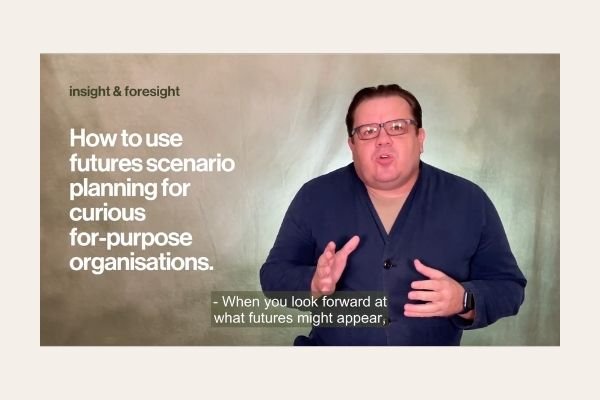foresights.
Sharing ideas, trends, issues and signals influencing the futures of organisations.
Search the blog;
Transforming your Business Model with Futures Intelligence.
You've been running your business for a few years now and you're starting to feel like you're stuck. The business model that made sense when your organisation started is no longer providing the results you're looking for. It’s time to find a better way.
Futures Scenario Planning.
Futures scenario planning is using future intelligence to inform alternative visions of possible, probable, and preferred futures, and interpreting how those futures might impact your organisation.
Backcasting - A Tool for Planning and Decision Making.
Backcasting is a powerful tool that can be used to manage change and uncertainty. It can help us to identify the steps we need to take to get from where we are now to where we want to be. If you’re facing a complex challenge, backcasting could be the answer.
Think Like a Futurist for Impact and Future Growth.
One way to make sense of what's happening is to think like a futurist. Futurists use foresight to examine trends and identify potential scenarios for the future. This helps them to see both the opportunities and the challenges that lie ahead.
The Business Case for Foresight.
Foresight is a critical business tool for today because it helps organisations to identify potential future opportunities and threats, adapt to rapidly changing and uncertain environments, and make better decisions. Foresight can help leaders understand the potential implications of deep changes in their industry or market, and enable them to maximise first-mover advantages.
5 Benefits of Using Foresight.
Foresight is the ability to see beyond the present and into the future, and when used correctly, it can provide several benefits. So if you're looking for a way to boost your organisation's performance, foresight may be just what you need. In this post, we'll explore five benefits of using foresight in business. Keep reading to learn more!
10 Tips to Manage Uncertainty and Fast-paced Change.
In today's rapidly changing world, it is more important than ever to be able to manage uncertainty and fast-paced change. Many organisations struggle with this, but there are ways to manage it effectively. Here are 10 tips to help you get started.
What is Futures Intelligence?
The future is now. The pace of change and innovation has never been so fast or relentless. As a result, organisations need to plan for impact and growth with an eye on the future - which means using futures intelligence: trends, signals, emerging changes data to build foresight.
Are Australian charities rich or poor?
The ACNC data set selected for analysis comprises 3,914 Large ($1M+ annual revenue) Australian charity entities with DGR Item 1 or 4 and ACNC Group entities who have submitted audited financial statements and conducted activities in 2019. These entities represent $102B of annual revenue, ~%60 of the total 2019 revenue reported by Australian charity entities to the ACNC.
Managing the Risk of Innovation.
Innovation is a tricky beast. It's not always clear that the risks outweigh the rewards. For those of us in for-purpose organisations, getting the business case right to fund innovation is critical; uncertainty can be a roadblock, but it doesn't have to be.
12 Questions to Get Started Using Strategic Foresight.
There is no one-size-fits-all answer when it comes to using strategic foresight in your business. The key is to experiment, find what works for you, and adapt as needed.
The Power of CPQQRT to Manage Complexity.
CPQQRT stands for Context, Purpose, Quality, Quantity, Resources, and Time. It was developed by Elliot Jaques, a Canadian organisational psychologist, and first referenced in 1994 in the book "Executive leadership: a practical guide to managing complexity".
How to Think About Futures.
A good way to create alternative views of futures is by building scenarios. This involves bringing together different trends, phenomena, and uncertainties to understand their interdependence and joint implications.
Why organisations need to start thinking 5 to 10 years ahead.
One way that long-range planning is enhanced is through the creation of various alternative futures, which are significantly different from one another. The scenarios that planners create can be based on different assumptions about technology, demography, economics, politics, and other factors.
Looking in the rearview mirror is not enough.
When it comes to planning, looking at what's in the rearview mirror is not enough. You need to look ahead through the windshield at the road ahead.
Elephants, Swans and Jellyfish for planning.
You can use the process of identifying Black Elephants, Swans and Jellyfish in your planning to drive new thinking, support diverse plans, build responsive systems and stretch your planning paradigms into longer time horizons.
Big challenges emerging for for-purpose CEOs and Boards.
For-purpose CEOs and Boards will need to consider some big challenges as they plan for the next 5 to 10 years.
2022: the year for longer-term planning?
The best response to the turbulence and uncertainty being faced by the not-for-profit sector is to focus on delivering long-term value. This means having a 5 to 10 view of how the world is changing and how your organisation will respond to, exploit, or mitigate these changes. This is not about the prediction of the future, a futile activity, but rather about being ready for what might happen next.
Two Frames for Planning & Decision Making.
Here’s two frames to help you with your planning and decision making:
Plans=knowledge+assumptions,
and
performance=Plans(reality)
"Benchmarking", "best practice" and "do like others" are not enough.
In a competitive world, an organisation's success is determined by its ability to stay ahead of others and adapt to the needs of its stakeholders and the fast-changing world it operates in.



















